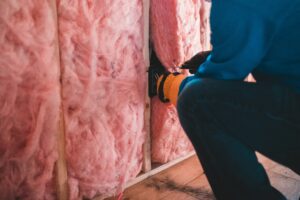
Insulation has been in the news a lot lately for a reason! If you’re looking to upgrade your home heating to something more environmentally friendly (and energy bill friendly!), starting with ensuring your home has good insulation is your best bet. It will ensure that whatever form of heating you choose, it will be operating at maximum efficiency.
IR heaters are a fantastic and efficient method of heating your home, able to produce a comfortable radiant heat. They can provide you with heat much faster than conventional radiators, and then our Lot20 Compliant NXTGEN panels are able to moderate themselves once the room is up to temperature.
However, like any kind of heating, IR heating will perform at its best when it’s supported by a well-insulated property. This will minimise the risk of heat being lost and wasted, and means the panel will need to be on less. We’ve picked out four popular methods of home insulation to tell you about!
Draught-Proofing
Draught-proofing your home is one of the simplest and most cost-effective ways to insulate your home. It prevents unwanted cold air from coming into your home, and helps keep warm air in. Costing around £200 for a typical semi-detached property, you could save around £25 a year!
IR heating is radiant, which means it heats objects directly rather than the air around you. This means it is less impacted by draughts, but it is still helpful to avoid feeling a chill in the first place!
Double & Triple Glazing
One of the more popular fixes for a poorly insulated home, double or triple glazing your windows will ensure heat doesn’t escape through thin glass windows.
This method is a lot more expensive, costing anywhere between £4250 to £15,000 depending on the size of your property and what windows you have. However, it can save you as much as £100 per year, making it a worthwhile investment.
Double glazed windows have the added benefit of improving sound insulation, so you won’t hear as much noise coming from the street outside. This makes this a great option if you live on a busy road! They also reduce condensation build-up, which combines brilliantly with the damp-reducing potential of an IR Heater.
There are some properties where double glazing isn’t an option- such as properties in a conservation area or listed buildings- but you can still use draught-proofing or other insulation methods (such as heavy curtains) for an extra boost.
Cavity Wall Insulation
Did you know that about a third of all heat lost in a home is lost through your walls? Most homes built from 1990 onwards have ample wall insulation, but if you have an older property, it could be worth looking into.
The cost of cavity wall insulation is incredibly variable, but as a rule of thumb you should make back the cost of installation in about five years thanks to the energy saving potential.
Roof & Loft Insulation
Around a quarter of heat is lost through the roof in an uninsulated home. Installing loft insulation is a quick and cheap way of negating this.
If your loft is accessible, you might be able to handle this job yourself, but if you want extra peace of mind there are plenty of specialists out there who can handle this task for a very reasonable price. The total cost will be variable based on the size of your home, but a total of around £1250 for an average 4-bedroom detached house it a good benchmark.
Loft insulation is a great investment for your future, since it’ll last for around 40 years, and pay for itself many times over!
All these methods of insulation combine brilliantly with the energy-saving potential of an IR heater, helping you get warm and stay warm for much less.
It’s also worth noting that our IR heaters are very inexpensive, and they’re very simple to install. If you can’t afford to shell out for both insulation and a more complicated heating method such as a heat pump, IR heaters won’t break the bank.
Whatever you decide – we are here for you. Give our team a call today on 0116 321 4124 to find the right panel for you or send us an email at sales@suryaheating.co.uk.
You can also check out our Facebook, Instagram and Twitter pages for some inspiration or head over to our YouTube channel to learn more about Infrared Heating.
All data and stats provided by the Energy Saving Trust.






 Accepted Here
Accepted Here